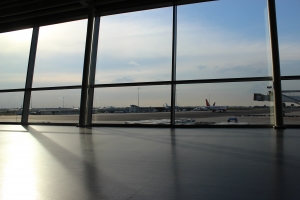
America’s airports no longer compete well on a global scale. Not a single one is currently ranked in the top 10 worldwide. That must change.
Funding has simply not been available and cities have been forced to “make do” for entirely too long. Change is coming though, as city leaders find innovative and collaborative ways to renovate expand and upgrade their airport facilities.
Major U.S. airport hubs such as Chicago, Dallas, Los Angeles and Atlanta are working hard to keep pace with new trends in the ever-evolving airline industry. To reduce labor and fuel costs, airlines now use larger airplanes that hold many more passengers. This has resulted in fewer and less frequent flights, and it forces more people to crowd into terminals that were never designed to accommodate such traffic. Most terminals were built to handle mid-sized planes – not the towering Boeing 787s that have become the norm. The airports are short on space, restrooms, guest seating and restaurant capacity. Security is problematic and crowding creates stress for everyone.
 Los Angeles International Airport (LAX) is a global hub but not a world class facility. In fact, its reputation as crowded, drab and lacking amenities is well known. Public transportation to the airport is scarce and traffic backs up as vehicles circle terminals in tight proximity. City leaders, however, are making dramatic changes as they implement a $14 billion plan.
Los Angeles International Airport (LAX) is a global hub but not a world class facility. In fact, its reputation as crowded, drab and lacking amenities is well known. Public transportation to the airport is scarce and traffic backs up as vehicles circle terminals in tight proximity. City leaders, however, are making dramatic changes as they implement a $14 billion plan.
LAX’s terminals are being updated, security is being enhanced, new baggage carousels will be added, car rental facilities and airport runways will be upgraded – changes that are long overdue. A glimpse of what is to come can be obtained by looking at the Tom Bradley International Terminal in Los Angeles. This airport was revamped and refurbished three years ago with a massive hall that includes new restaurants, LED screens that project the state’s natural wonders and flight information. Transportation options will be expanded as the facility is linked to the LA Metro rail network.
San Francisco International Airport recently launched a $5.7 billion plan to upgrade facilities, expand public transportation options and refurbish airline gates. The busiest airport in the world, Atlanta’s Hartfield-Jackson International, has launched its own $6 billion effort to add more gates, parking garages and amenities. Even mid-sized airports, such as North Carolina’s Charlotte Douglas International, have started to expand runways and add newer air-traffic control towers.
Traffic congestion at U.S. airports has been problematic for years. Almost every city needs more transportation options. People movers, light-rail and “inter-modal” stations that connect passengers to car rental services and parking garages are becoming common.
Another interesting trend that is impacting America’s airports is “collaboration.” Major airlines are joining forces with cities. Some have provided funding and others are making in-kind contributions. United Airlines added “smart lanes” at the Transportation Security Administration (TSA) security check inside the LAX terminal. This allows passengers to move through security at their own pace. Quicker passengers can speed through security while early arrivers can leisurely proceed without holding up others. Both airline officials and city leaders know that making travel less stressful for travelers will result in very positive outcomes.
As other airports follow with upgrades and major renovations, additional trends will evolve. Collaboration between cities and companies that operate airports throughout the world will likely become the norm. Partnerships between cities and airport operators that enhance the ease and enjoyment of air travel are common in other countries. America is expected to move more aggressively in that direction. As that happens, America’s airports will hopefully emerge and begin moving up in the ranks of top tier aviation facilities worldwide. It’s definitely time for that to happen.
Want to read more stories like this one? Check out the most recent editions of Government Contracting Pipeline and Texas Government Insider. SPI’s government contracting consultants assist firms of all types in selling to government. Contact them today.
